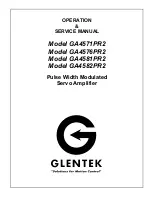
GLENTEK Inc. 208 Standard Street, El Segundo, California 90245, U.S.A. (310) 322-3026
15
CHAPTER FOUR: THEORY OF OPERATION
4.1 INTRODUCTION TO THEORY OF OPERATION:
A velocity-mode servo amplifier is essentially comprised of two control loops (fig. 4.1).
Figure 4.1
The inside control loop is referred to as the “current loop” and the outside loop is referred to as the “velocity
loop”. Before we begin our analysis of the current loop, let us review some basic concepts which will help you to
better understand the amplifier’s operation.
4.2 OPERATION OF OUTPUT SWITCHING TRANSISTORS:
The output transistors, for all intents and purposes, operate in only two states. They are analogous to
ON/ OFF switches. When an output transistor is OFF, there is no current flowing through it (its resistance is infi-
nite). When an output transistor is ON, current flows through it (its resistance is near zero). When the t r a n s i s -
tor is ON, it is technically referred to as being in saturation.
4.3 “H TYPE” OUTPUT BRIDGE CONFIGURATION:
The output configuration of the amplifier is an “H TYPE” bridge (see fig. 4.2 for schematic representation of
output bridge with motor connected).
Figure 4.2
The advantage of an “H TYPE” output bridge configuration is that by controlling the switching of the oppo-
site pairs of transistors, current can be made to flow through the motor in either direction using a single-polarity
power supply as shown in figure 4.2.
CHAPTER FOUR: THEORY OF OPERATION
















































